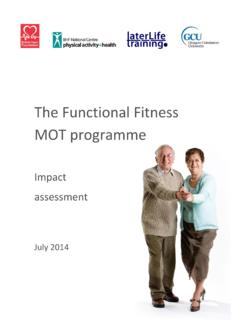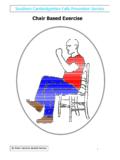Transcription of Circuit class therapy for improving mobility after …
1 Circuit class therapy for improving mobility after stroke (Review). English C, Hillier SL. This is a reprint of a Cochrane review, prepared and maintained by The Cochrane Collaboration and published in The Cochrane Library 2010, Issue 7. Circuit class therapy for improving mobility after stroke (Review). Copyright 2010 The Cochrane Collaboration. Published by John Wiley & Sons, Ltd. TABLE OF CONTENTS. HEADER .. 1. ABSTRACT .. 1. PLAIN LANGUAGE SUMMARY .. 2. BACKGROUND .. 2. OBJECTIVES .. 3. METHODS .. 3. RESULTS .. 6. Figure 1.. 7. Figure 2.. 8. DISCUSSION .. 9. AUTHORS' CONCLUSIONS .. 11. ACKNOWLEDGEMENTS .. 11. REFERENCES .. 11. CHARACTERISTICS OF STUDIES .. 14. DATA AND ANALYSES .. 22. Analysis Comparison 1 Circuit class therapy versus other, Outcome 1 6mWT.. 22. Analysis Comparison 1 Circuit class therapy versus other, Outcome 2 Gait speed.. 23. Analysis Comparison 1 Circuit class therapy versus other, Outcome 3 Step Test.
2 23. Analysis Comparison 1 Circuit class therapy versus other, Outcome 4 Timed Up and Go.. 24. Analysis Comparison 1 Circuit class therapy versus other, Outcome 5 Berg Balance Scale.. 24. Analysis Comparison 1 Circuit class therapy versus other, Outcome 6 Activities-specific Balance Confidence Scale. 25. Analysis Comparison 1 Circuit class therapy versus other, Outcome 7 Length of stay.. 25. Analysis Comparison 1 Circuit class therapy versus other, Outcome 8 Gait speed: sensitivity analysis.. 26. Analysis Comparison 1 Circuit class therapy versus other, Outcome 9 Berg Balance Scale: sensitivity analysis.. 26. Analysis Comparison 1 Circuit class therapy versus other, Outcome 10 Length of stay: sensitivity analysis.. 27. APPENDICES .. 27. HISTORY .. 28. CONTRIBUTIONS OF AUTHORS .. 28. DECLARATIONS OF INTEREST .. 28. SOURCES OF SUPPORT .. 28. DIFFERENCES BETWEEN PROTOCOL AND REVIEW.
3 29. Circuit class therapy for improving mobility after stroke (Review) i Copyright 2010 The Cochrane Collaboration. Published by John Wiley & Sons, Ltd. [Intervention Review]. Circuit class therapy for improving mobility after stroke Coralie English1 , Susan L Hillier1. 1 Centre for Allied Health Evidence, University of South Australia (City East), Adelaide, Australia Contact address: Susan L Hillier, Centre for Allied Health Evidence, University of South Australia (City East), North Terrace, Adelaide, SA, 5000, Australia. Editorial group: Cochrane Stroke Group. Publication status and date: New, published in Issue 7, 2010. Review content assessed as up-to-date: 21 October 2009. Citation: English C, Hillier SL. Circuit class therapy for improving mobility after stroke. Cochrane Database of Systematic Reviews 2010, Issue 7. Art. No.: CD007513. DOI: Copyright 2010 The Cochrane Collaboration.
4 Published by John Wiley & Sons, Ltd. ABSTRACT. Background Circuit class therapy (CCT) offers a supervised group forum for people after stroke to practise tasks, enabling increased practise time without increasing staffing. Objectives To examine the effectiveness and safety of CCT on mobility in adults with stroke. Search strategy We searched the Cochrane Stroke Group Trials Register (last searched October 2009), the Cochrane Central Register of Controlled Trials (CENTRAL) (The Cochrane Library, Issue 2, 2009), MEDLINE (1950 to November 2008), EMBASE (1980 to November 2008), CINAHL (1982 to November 2008) and 14 other electronic databases (to November 2008). We also searched proceedings from relevant conferences, reference lists and unpublished theses; contacted authors of published trials and other experts in the field;. and searched relevant clinical trials and research registers.
5 Selection criteria Randomised or quasi-randomised controlled trials including people over 18 years old diagnosed with stroke of any severity, at any stage, or in any setting, receiving CCT. Data collection and analysis Two review authors independently selected trials for inclusion, assessed methodological quality and extracted data. Main results We included six trials involving 292 participants. Participants were long-term stroke survivors living in the community or receiving inpatient rehabilitation. All could walk 10 metres with or without assistance. Four studies measured walking capacity and three measured gait speed, demonstrating that CCT was superior to the comparison intervention (Six Minute Walk Test: mean difference (MD), fixed metres, 95% confidence interval (CI) to , P < ; gait speed: MD, fixed m/s, 95% CI to , P. = 004). Two studies measured balance, showing a superior effect in favour of CCT (Step Test: MD, fixed steps, 95% CI to , P = ; activities-specific balance and confidence: MD, fixed , 95% CI to , P = ).
6 Studies also measured other balance items showing no difference in effect. Length of stay (two studies) showed a significant effect in favour of CCT (MD, fixed days, 95% CI to , P = ). Only two studies measured adverse events (falls during therapy ): all were minor. Circuit class therapy for improving mobility after stroke (Review) 1. Copyright 2010 The Cochrane Collaboration. Published by John Wiley & Sons, Ltd. Authors' conclusions CCT is safe and effective in improving mobility for people after moderate stroke and may reduce inpatient length of stay. Further research is required, investigating quality of life, participation and cost-benefits, that compares CCT to standard care and that also investigates the differential effects of stroke severity, latency and age. PLAIN LANGUAGE SUMMARY. Circuit class therapy for improving mobility after stroke Stroke is a major cause of increased dependence for survivors in many activities of daily life, including the ability to walk and negotiate our usual environments.
7 Intensive rehabilitation, with time spent practising specific tasks or functions under supervision, is very beneficial but achieving the sufficient amount of therapy time can be difficult if there is always a one staff to one client ratio. Circuit class therapy offers people with stroke the chance to practise meaningful functions in a group setting with the supervision of staff to give feedback and to progress the training. We found six studies involving 292 participants that compared this kind of rehabilitation to usual care or sham rehabilitation. All the trials reported benefits of Circuit classes for improving the person's mobility . More specifically, we combined the results from the studies and found that the classes were more effective in improving the person's ability to walk further, longer or faster and to balance more easily and confidently when compared to other types of exercise.
8 Also, people receiving the classes went home from inpatient rehabilitation earlier than the comparison groups. There were no increased risks of falling related to participating in the Circuit classes. We are recommending people can attend Circuit class therapy after stroke to achieve benefits in their ability to walk and balance. However, more research is needed to see if it works for all people at any stage or severity after stroke and if some tasks are better to practise than others. BACKGROUND. are that therapy is provided in a group setting with more than two participants per therapist, and there is a focus on repetitive Description of the condition practise of functional tasks and continual progression of exercises (English 2007; Wevers 2009). Participants may complete a se- Stroke is a leading cause of death and disability in many Western ries of workstations arranged in a Circuit (Wevers 2009) or may nations.
9 In Australia, the United Kingdom and the United States complete a series of individualised exercises within a group setting of America it is within the top 10 causes of long-term physical (English 2007). Circuit class therapy differs from physiological ex- disability (Begg 2007; Muntner 2002; Wolfe 2000). Stroke care is ercise programs, which aim to effect improvements in strength or costly: in Australia an estimated 50% of stroke survivors require a aerobic fitness. While many of the activities and exercises may have period of inpatient rehabilitation at an estimated cost of 14,000 a strength or fitness component, the primary focus is on repetitive AUD per person (Dewey 2003). The setting in which stroke sur- practise of task-specific training of everyday motor tasks. Circuit vivors receive rehabilitative care (inpatient, hospital-based versus class therapy also differs from the conventional one-therapist-to- community outpatient-based) may vary between countries.
10 How- one-patient model for the provision of physical therapy for reha- ever, the costs involved in delivering the care are consistently high, bilitation. The group nature of the intervention potentially allows thereby placing pressure on rehabilitation services to provide evi- a greater amount of therapy to be provided to patients for the same dence-based therapies that are also cost effective. cost. Circuit class therapy is usually directed at either improving mo- bility (walking ability, functional balance ability) or improving Description of the intervention use of the hemiparetic upper limb, although one study included both mobility and upper limb training within the one interven- Group Circuit class therapy (CCT) describes a model of therapy tion (English 2007). The majority of studies have investigated the delivery that utilises active exercises and activities which are task use of Circuit class therapy for improving mobility , thus this will specific (practising the functional task itself or part thereof ) and be the focus of this review.



